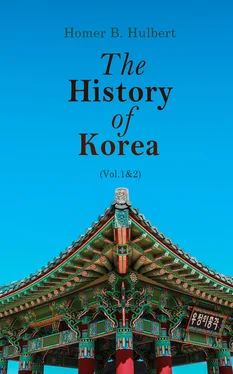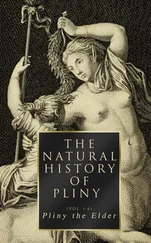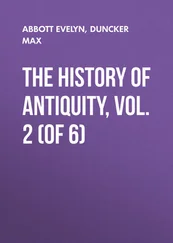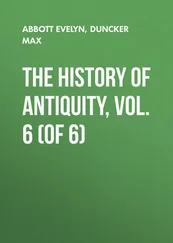It must be remembered that as yet neither of the “Three Kingdoms” had begun to occupy all the territory that nominally belonged to it or that lay within its “sphere of influence.” Between them lay large tracts of land as yet unoccupied except by wild tribes. It is more than probable that at no point did any of these kingdoms actually touch each other. Ko-gu-ryŭ was broadening out northwards, Păk-je was at a standstill and Sil-la was growing rather by immigration than by occupation of new territory. As yet Sil-la had taken but four districts outside of the original six, and so we see that a large part of the south was still in the hands of the original inhabitants as given in the list of the settlements of the three Hans. In 41 A.D. the nine districts whose names ended in kan, namely A-do-gan, Yö-do-gan, P’i-do-gan, O-do-gan, Yu-su-gan, Yu-ch’ŭn-gan, Sin-ch’ŭn-gan, Sin-gwi-gan and O-ch’ŭn-gan, formed a confederacy and called it the “Kingdom of Ka-rak”. They placed their capital at Ka-rak, the present town of Kim-hă, and made Keum Su-ro their king. Tradition says that he obtained his Queen in the following way. A boat approached the shore bearing a beautiful woman, Queen Ho, whose ornamental name was Whang-ok or “Yellow Jade”. She came from the far southern kingdom of A-yu-t’a, otherwise known as Ch’ŭn-ch’uk. It is said that she lived a hundred and fifty-seven years and that the king survived her one year. All that is told us of the history of this rival of Sil-la is the list of her kings which will be found in the chronological tables. After an existence of 491 years it came to an end in the reign of the Sil-la king Pŭp-heung. It is also affirmed that when Sil-la fell in 935, some worthless wretches who defiled the grave of Keum Su-ro were mysteriously killed, one by the falling of a beam, one by an invisible archer and nine others by a serpent eighteen feet long. The records say that when the Japanese, at the time of the great invasion three centuries ago, dug open this king’s grave they found great store of gold and jade. The skull of the monarch was of prodigious size, and beside his body lay two women whose features were well preserved but which dissolved and melted away when exposed to the air. It is barely possible that we here have an indication that embalming was practiced, but if so we have no other intimation of it.
Ka-rak extended eastward as far as Wang-san River, six miles to the west of the present Yang-san; to the north-east as far as Ka-ya San, the present Ko-ryŭng; to the south and south-west as far as the coast and on the west to Chi-ri San. From this we see that it was little inferior to Sil-la in size.
Ka-rak had five dependencies, namely the districts known under the common name of Ka-ya. They were So-ga-ya, Ko-ryŭng-ga-ya, Song-san-ga-ya, Tă-ga-ya and A-ra-ga-ya. They correspond respectively to the present towns of Ko-sŭng, Ham-ch’ang, Ham-ch’ang, Sŭng-ju, Ko-ryŭng andHam-ch’ang, Ham-ch’ang, Sŭng-ju, Ko-ryŭng and Ham-an. Tradition says that one day when the chiefs of the nine tribes of Ka-rak were banqueting they saw upon the slope of Sung-bong, called also Ku-yii-bong, a singular cloud. From the sky above it came a voice. They hastened up the mountain and there found a golden box containing six golden eggs. These opened and disclosed six boys. One of them was Keum Su-rothem was Keum Su-ro who became king of Ka-rak and the other five were made chiefs of the five Ka-ya, subject to Ka-rak. Of these Ka-ya states we know the founder of only one. He was descended from Kyŏn-mo-ju, the female divinity of Ka-ya Mountain who wedded a celestial being, Yi-ja-ga. Their off-spring was Yi-i-a-si, who founded one of the Ka-ya states. The Ka-ya states fell before Sil-la some five hundred years later in the reign of King Chin-heung.
Table of Contents
Vicissitudes of Ko-gu-ryu … last Ma-han chief joins Sil-la. … Pak-je and Sil-la become sworn enemies … legend of Kye-rim. … Pak-je worsted. … Ko-gu-ryu’s strength on the increase. … Sil-la’s rapid growth. … Ka-ya attacks Sil-la. … Ko-gu-ryu make compact with Ye-mak. … Su-sŭng’s evil reign … roads in Sil-la. … Japanese raid … legend … an epicurean. … Pak-je’s victory … origin of government loans. … Yun-u’s trickery … capital of Ko-gu-ryu moved … wild tribes attack Sil-la … democratic ideas in Sil-la. … Ko-gu-ryu breaks with China … and attacks Sil-la. … China invades Ko-gu-ryu … the king retreats … relieved through treachery … capital of Ko-gu-ryu moved to P’yung-yang … beginning of feud between Korea and Japan … reforms in Pak-je … third century closes … progress of Sil-la … how Eul-bul became king of Ko-gu-ryuKo-gu-ryu … a noble lady of Sil-la isis sent to Japan.
Mu-hyŭl, the third king of Ko-gu-ryŭ died in 45, leaving the kingdom to the tender mercies of his son a worthless debauchee. Four years later he in turn made way for Hă-u, a member of a collateral branch of the family. Following the traditions ofof Ko-gu-ryŭ this ruler professed loyalty to China on the one hand and seizedseized all the Chinese territory he could lay hands on, on the other. In 54 he was assassinated by one Tu-no and the seven year old grandson of king Yu-ri was placed on the throne, a regent being appointed to carry on the government until the boy reached his majority. The good work continued. Ten forts were built in western Liao-tung to guard against Chinese advances, which shows that she had regained nearly all the territory she had lost at the hands of the parvenu Wang-mang. The following year she took formal possession of the territory of Ok-jŭ on the eastern coast.
In the year 58 Yu-ri, the third king of Sil-la died. He must not be confounded with Yu-ri the second king of Ko-gu-ryŭ. The sound is the same but the character is different. It was he who had the difference of opinion with Sŭk-t’al-hă in regard to the succession. As he died without issue the reins of government naturally passed into the hands of the aged statesman Sŭk-t’al-hă. He was sixty-two years old when he assumed the cares of royalty. In his fifth year the one remaining Ma-han chief, Măng-so, who had escaped the appetite of Păk-je, went over to Sil-la, as he concluded it was no longer possible to prolong a hopeless struggle againstagainst Păk-je. Pok-am fortress thus passed into the hands of Sil-la. Strange to say Păk-je not only did not resent this but even made overtures to Sil-la for a friendly meeting of their respective kings in the following year. Sil-la refused to sanction this, and the rebuff was too much for the equanimity of Păk-je. From that day the attitude of Păk-je toward Sil-la was one of studied hostility, broken only by an occasional spasmodic attempt at reconciliation. Among the three kingdoms, Sil-la was the only one that preserved her dignity intact and kept herself untainted by the charge either of avarice or pusilanimitypusilanimity.
The year 66 brought forth another of those wonders that embellishembellish the legendary lore of Korea. The king of Sil-la was wakened one night by the loud cackling of a hen, which seemed to come from a forest to the south. A messenger was sent to see what was the cause of the disturbance and he found a box hanging from the branch of a tree, while on the ground beneath it there cluttered a white hen. When the box was placed before the king and he had opened it a handsome child was found. It received the name Keum Yun-ji. Some say this Yŭn-ji was merely a part of the name while others affirm that it is a pure Sil-la word meaning “baby”. Up to this time the kingdom had been called Sŭ-ra-bŭl but now the king changed it to Kye-rim, kye meaning “hen” and rim meaning “woods.” So the kingdom was called “Hen in the Woods”, not a very dignified name but one, perhaps, that fitted well the military prowess of the kingdom.
Читать дальше












